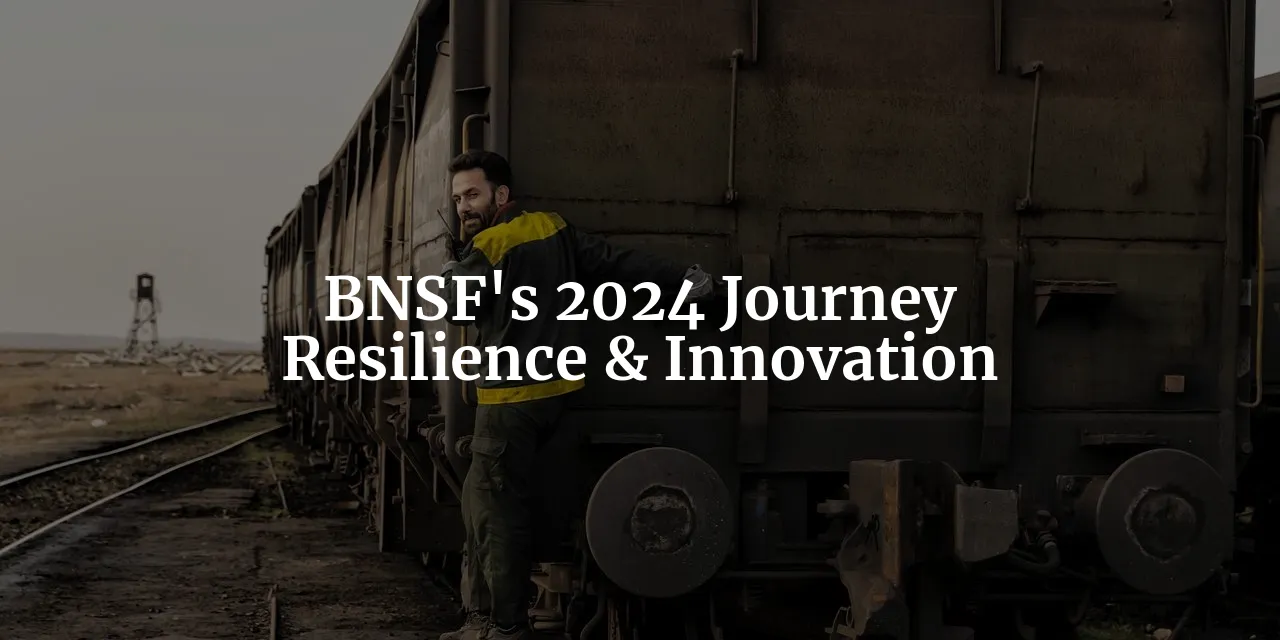Tags: BNSF / Earnings / History
This fanpage is not officially affiliated with Berkshire Hathaway: Disclaimer
Berkshire Hathaway's BNSF has faced challenges in Q1 2024. Explore financial performance, strategic adjustments, historical context, safety initiatives, economic indicators. Discover how BNSF's market position and innovation pave the way for long-term growth and value creation for Berkshire.

Introduction
BNSF Railway, a pivotal force in the American transportation landscape, operates one of the most extensive railroad systems in North America, with over 33,400 miles of track across 28 states and three Canadian provinces 5. As a subsidiary of Berkshire Hathaway since 2010, BNSF not only represents a significant component of the conglomerate's portfolio but also plays a crucial role in the economic infrastructure of the United States with its 37,000 employees. The railroad industry, historically integral to the nation's development, continues to be a backbone for economic activity, facilitating the efficient movement of goods across vast distances. Yes, railroads are integral part to any sustainability agenda.
2023 was already challenging for BNSF and we thought it was probably "time to worry" ↗. In the first quarter of 2024, BNSF faced a series of operational and economic challenges that impacted its financial performance. This article aims to dissect these challenges, providing Berkshire Hathaway shareholders with a comprehensive analysis of the company's financial health and strategic direction. By understanding the factors that influenced BNSF's performance in early 2024, stakeholders can gain insights into potential future strategies that could steer the company towards recovery and growth.
BNSF's Financial Performance in Q1 2024
The first quarter of 2024 was marked by a noticeable downturn in BNSF’s financial metrics. The company reported net earnings of $1,143 million, a decline from $1,247 million in the same quarter of the previous year 1. Total revenue also saw a reduction, amounting to $5.660 billion, which represents a 6% decrease from the first quarter of 2023 3. This downturn can be attributed to a combination of lower fuel surcharge revenue and an unfavorable business mix, despite a 7% increase in unit volume 3.
When comparing these figures with previous years, a trend of fluctuating financial performance becomes evident. For instance, in the first quarter of 2022, BNSF enjoyed a substantial increase in railroad operating revenues by 10.6% compared to 2021, with net earnings rising to $1,371 million from $1,251 million 2. The contrast between these periods highlights the volatility in the railroad industry, influenced by external economic conditions and internal operational efficiencies.
| Quarter | BNSF Net Earnings (in million $) |
|---|---|
| Q1 2024 | $1,143 😯 |
| Q1 2023 | $1,247 |
| Q1 2022 | $1,371 😎 |
| Q1 2021 | $1,251 |
| Q1 2020 | $1,190 |
| Q1 2019 | $1,253 |
The data in the above table has been derived from recent first quarter reports from Berkshire Hathaway 12. As we can see, the first quarter 2024 showed the lowest first quarter earnings during the last five years. The decline in operating income by 7% and the increase in the operating ratio to 69.5% in the first quarter of 2024 further underscore the financial pressures faced by BNSF 3. These metrics are critical as they reflect the company’s profitability and operational efficiency, where a higher operating ratio indicates a decrease in profitability.
Analyzing the specifics of the revenue streams, the consumer products sector was a relative bright spot, with operating revenues increasing by 5.5% due to a significant 19.3% rise in volumes 1. However, other sectors did not perform as well. The coal sector experienced the most substantial decline, with revenues plummeting by 25.7% alongside a 20.6% drop in volumes 1. This stark decrease highlights the ongoing challenges in the coal industry, compounded by broader economic shifts towards alternative energy sources.
The decrease in operating expenses by $105 million, primarily due to reduced fuel expenses and purchased services, provides a silver lining, suggesting that BNSF is actively managing its cost base in a challenging environment 1. However, the increase in compensation and benefits expenses by $94 million indicates rising costs in maintaining and acquiring skilled labor 1.
These financial challenges reflect not only the internal dynamics of BNSF but also broader economic conditions and sector-specific issues. For Berkshire Hathaway shareholders, understanding these nuances is crucial for assessing the long-term value and potential of BNSF. As the company navigates through these turbulent times, strategic adjustments and operational efficiencies will be key to stabilizing performance and fostering growth in subsequent quarters.
Operational Challenges and Strategic Adjustments
In the first quarter of 2024, BNSF faced a series of operational challenges that significantly impacted its performance. One of the most notable issues was the decline in coal volumes, which plummeted by 20.6%, contributing to a 25.7% drop in operating revenues from this segment 1. Additionally, the average revenue per car/unit saw a substantial decrease of 9.9%, further exacerbating the financial strain 1.
In response to these challenges, BNSF's management, led by Greg Abel, implemented strategic adjustments aimed at reshaping the company's cost structure. As Abel pointed out, the necessity to "reset the cost structure to match demand" was critical in 2023, and efforts continued into 2024 6. This involved a meticulous review and reallocation of resources, emphasizing areas like rail yards, locomotive fleet utilization, and employee resource allocation to enhance efficiency 6.
A silver lining in these adjustments was the remarkable 19% increase in Consumer Products volumes, signaling a potential growth area for BNSF 3. This uptick is significant, as it not only offsets some of the losses from other segments but also positions the company to capitalize on emerging market opportunities.
Moreover, the decrease in operating expenses by 5% from the previous year, primarily due to lower fuel costs and purchased services expenses, highlights the positive outcomes of BNSF's strategic cost management 3. These savings are crucial in maintaining financial stability and allowing for potential reinvestment into growth areas.
The adoption of precision scheduled railroading metrics also plays a pivotal role in BNSF's strategy to improve performance. By enhancing the predictability and efficiency of train operations, BNSF aims to better meet customer demands and adapt to the flat demand across the rail industry 6.
Looking forward, BNSF is likely to continue exploring further investments to reduce future costs and improve service reliability. These long-term strategies are essential for stabilizing and expanding the business in a competitive and ever-evolving industry.

Historical Context and Industry Evolution
BNSF Railway, a major North American railroad, boasts a rich history that dates back to its formation on September 22, 1995, through the merger of Atchison, Topeka and Santa Fe Railway and Burlington Northern Railroad 5. This merger was a strategic move to consolidate resources and expertise, setting the stage for future growth and expansion.
The historical importance of railroads in America's expansion cannot be overstated. Railroads were instrumental in the westward expansion, facilitating the transport of goods and people across vast distances. They played a critical role in shaping the economic landscape of the United States, driving industrial growth and urban development.
Over the decades, the railroad industry has undergone significant evolution, marked by technological advancements and regulatory changes. The introduction of diesel locomotives, computerized scheduling systems, and advanced safety protocols have transformed the operational dynamics of railroads.
BNSF's journey has been influenced by these historical trends, as well as by economic downturns and shifts in industrial demand. The acquisition by Berkshire Hathaway in February 2010 marked a pivotal moment, aligning BNSF with Warren Buffett's long-term investment philosophy and providing substantial financial backing 5.
The competitive landscape in which BNSF operates is notably characterized by a duopoly with Union Pacific Railroad, dominating the transcontinental freight rail lines in the Western, Midwestern, and Southern United States 5. This unique position underscores the strategic importance of BNSF in the national transportation infrastructure.
As we look to the future, the railroad industry is likely to continue evolving, potentially influenced by further technological innovations, environmental considerations, and shifts in global trade patterns. For BNSF, staying ahead of these trends and adapting strategically will be crucial in maintaining its leadership position and delivering value to its stakeholders.
Safety Initiatives and Regulatory Compliance
In a significant stride toward enhancing operational safety, BNSF Railway has partnered with the American Train Dispatchers Association (ATDA) and the Federal Railroad Administration (FRA) to implement the Confidential Close Call Reporting System (C3RS). This initiative marks a pivotal moment in the rail industry's commitment to safety and regulatory compliance 4.
The C3RS program, sponsored by the FRA, is designed to improve railroad safety by allowing railroad employees to report potentially unsafe events confidentially and without fear of reprisal. This approach not only helps in identifying and mitigating risks before they lead to accidents but also fosters a culture of trust and safety among the workforce. BNSF's participation in this one-year pilot reflects the company's proactive stance on safety issues, as emphasized by BNSF President & CEO Katie Farmer, who stated, "BNSF is committed to improving safety on our railroad and is proud to have reached an agreement to voluntarily participate with ATDA in C3RS" 4.
The support from industry stakeholders has been robust ↗. ATDA President Ed Dowell highlighted the significance of this initiative, noting, "The adoption of the C3RS at BNSF marks a pivotal moment for rail safety." Such endorsements underscore the potential of C3RS to set new safety benchmarks across the railroad industry. FRA Administrator Amit Bose also supported this sentiment by emphasizing the importance of rail workers' insights in driving safety innovations 4.
The broader implications of such safety initiatives are substantial. They not only enhance operational safety but also boost investor confidence and public perception of BNSF. In an industry where safety is paramount, initiatives like C3RS could also prompt regulatory changes, pushing other companies to adopt similar measures. As BNSF continues to lead by example, the potential for industry-wide enhancements in safety standards seems promising, aligning with the long-term interests of shareholders and stakeholders alike.
Economic Indicators and Market Conditions
The economic landscape in which BNSF operates is influenced by a myriad of factors, including fuel prices, industrial production, and trade volumes. In the first quarter of 2024, BNSF faced several economic challenges that impacted its operations. Notably, there was a significant decline in average revenue per car/unit by 9.9%, despite a 6.6% increase in volumes. This discrepancy highlights the pressures on pricing and the competitive dynamics within the industry 1.
Fuel expenses, a critical cost component for BNSF, saw a decrease of $110 million (11.4%) in the first quarter of 2024 compared to the previous year. This reduction in fuel costs should theoretically bolster the company's financial performance, but the decline in revenue per unit moderated these gains 1.
The broader market conditions also reflect the impact of global economic trends, such as trade wars or geopolitical instabilities, which could further affect BNSF's operations. For instance, fluctuations in global trade volumes can directly influence the volume of goods transported, affecting revenue streams across different business segments. The decline in coal volumes and the corresponding drop in revenue from this segment in the first quarter of 2024 is a stark indicator of how external market forces can impact sector-specific operations 1.
Given these challenges, BNSF might need to adjust its strategy to navigate the ongoing economic uncertainty. This could involve exploring more efficient operational techniques, diversifying the commodity mix, or enhancing service offerings to capture new market segments. Such strategic adjustments will be crucial for maintaining competitiveness and ensuring sustainable growth in a fluctuating economic environment.
By closely monitoring these economic indicators and adapting strategies accordingly, BNSF can better position itself to leverage opportunities and mitigate risks, aligning with the long-term interests of its shareholders and enhancing its market resilience.
Shareholder Perspectives and Investment Considerations
As BNSF navigates through the complexities of 2024, shareholders of Berkshire Hathaway are keenly observing how the railroad's performance impacts their investments. The recent comments from Warren Buffett and Greg Abel highlight a pivotal moment for BNSF, emphasizing the need for continuous improvement and strategic adjustments to align with the evolving demands of the rail industry 6. This section delves into the implications of BNSF's current trajectory for Berkshire Hathaway shareholders, explores their concerns and expectations, and discusses the railroad's role within the conglomerate's diverse portfolio of subsidiaries.
The section is largely based on the recent comments by Warren Buffett and Greg Abel on BNSF's performance during this years shareholder meeting:
Implications of BNSF's Performance. BNSF's performance in early 2024, characterized by declining revenue and profit margins, has raised important considerations for shareholders. As the largest freight railroad under Berkshire Hathaway, BNSF's financial health is crucial. The acknowledgment by Buffett and Abel that the cost structure was not adequately adjusted to meet the flat demand in 2023 suggests a reactive approach that shareholders hope will shift towards more proactive strategies 6. The efforts to improve precision scheduled railroading metrics and optimize resource allocation are seen as essential steps towards enhancing operational efficiency and, ultimately, profitability 6.
Shareholder Concerns and Expectations. Shareholders are understandably concerned about BNSF's ability to recover and grow amidst industry-wide challenges. The expectation is not only for a rebound but also for pioneering strategies that set BNSF apart in a competitive field. Shareholders expect the management's promises of resetting the cost structure and improving operational metrics to materialize into tangible outcomes. There is a keen interest in seeing how BNSF leverages its vast service territory and capital expenditure leadership to regain and expand its market share 6.
BNSF's Role in Berkshire Hathaway's Portfolio. Within Berkshire Hathaway's portfolio, BNSF represents a significant component of the conglomerate's commitment to infrastructure and long-term investments. Acquired for $35 billion in 2009, BNSF is not just a financial asset but a critical element in the U.S. transportation infrastructure, making it a strategic investment with implications for national economic health and Berkshire's bottom line 6. Warren Buffett’s philosophy of acquiring and holding substantial assets that deliver consistent, long-term value aligns with the nature of the railroad industry, which is foundational yet fraught with complex, capital-intensive challenges.
Long-term Investment Perspective. Warren Buffett's investment strategy has always been about the long haul, and this perspective is particularly relevant to BNSF's current challenges. Despite the immediate concerns, the overarching view among shareholders is that railroads remain a vital part of America's economic engine. The belief in railroads as a long-term investment that will continue to yield benefits aligns with Buffett’s strategy of investing in industries that have a durable competitive advantage and are essential to the country’s infrastructure 6.
The commitment to continuous improvement, as emphasized by Buffett and Abel, is not just a strategy but a necessity in the evolving economic landscape.

Conclusion
The journey of BNSF Railway through the challenges of 2024 serves as a litmus test for its adaptability and resilience in the face of evolving market dynamics. The financial performance in the first quarter of 2024, marked by declining revenue and profit margins, underscores the need for strategic adjustments and operational efficiencies to navigate the industry's complexities ↗. Despite the downturn, BNSF's management, under the leadership of Greg Abel, has shown a commitment to realigning the cost structure, optimizing resource allocation, and enhancing operational metrics to drive profitability and growth.
The historical context of BNSF's evolution, from its merger in 1995 to its acquisition by Berkshire Hathaway in 2009, highlights the company's strategic importance in the national transportation infrastructure ↗. As a significant component of Berkshire Hathaway's diverse portfolio, BNSF embodies the conglomerate's long-term investment philosophy and commitment to essential infrastructure assets. Warren Buffett's emphasis on acquiring and holding assets that deliver consistent, long-term value aligns with the enduring nature of the railroad industry, despite its inherent challenges.
The safety initiatives and regulatory compliance efforts undertaken by BNSF, such as the implementation of the Confidential Close Call Reporting System (C3RS), demonstrate the company's proactive stance on enhancing operational safety and fostering a culture of trust among its workforce. These initiatives not only improve safety standards but also enhance investor confidence and public perception of BNSF as a responsible corporate entity.
Amidst economic indicators and market conditions that pose challenges, BNSF's strategic responses and operational adjustments position the company for future success. By leveraging its vast service territory, capital expenditure leadership, and commitment to continuous improvement, BNSF aims to navigate the evolving economic landscape and emerge stronger and more competitive in the long run.
The resilience of the railroad industry, exemplified by BNSF's strategic initiatives and commitment to innovation, underscores the potential for growth and value creation in the face of changing market dynamics. As BNSF continues to adapt and evolve, it remains a cornerstone asset in Berkshire Hathaway's portfolio, embodying the conglomerate's ethos of long-term, value-driven investing in essential infrastructure assets. The future holds promise for BNSF as it charts a course towards sustainable growth and operational excellence in the dynamic railroad industry.
References
-
First Quarter 2022 - www.berkshirehathaway.com ↩↩
-
BNSF 1Q24: Revenue Down; OR Increases - Railway Age - www.railwayage.com ↩↩↩↩↩
-
BNSF Railway, ATDA and FRA reach C3RS safety agreement - www.bnsf.com ↩↩↩
-
BNSF Railway - Wikipedia - en.wikipedia.org ↩↩↩↩
-
Transcript: Berkshire’s 2024 annual shareholder meeting - steadycompounding.com ↩↩↩↩↩↩↩↩↩












